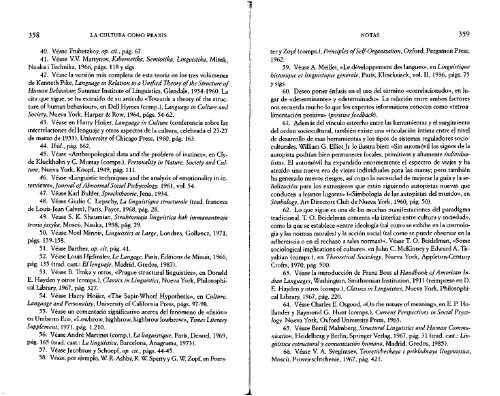Zygmunt Bauman La cultura como praxis
Zygmunt Bauman La cultura como praxis
Zygmunt Bauman La cultura como praxis
You also want an ePaper? Increase the reach of your titles
YUMPU automatically turns print PDFs into web optimized ePapers that Google loves.
358 LA CULTURA COMO PRAXIS<br />
40. Véase Trubetzkoy, op. cit., pág. 67.<br />
41. Véase V.V. Martynov, Kibernetika, Semiotika, Lingvistika, Minsk,<br />
Nauka i Technika, 1966, págs. 118 y sigs.<br />
42. Véase la versión más completa de esta teoría en los tres volúmenes<br />
de Kenneth Pike, <strong>La</strong>nguage in Relation to a Unified Theory ofthe Structure of<br />
Human Behaviour, Summer Institute of Linguistics, Glendale, 1954-1960. <strong>La</strong><br />
cita que sigue, se ha extraído de su artículo «Towards a theory of the structure<br />
of human behaviour», en Dell Hymes (comp.), <strong>La</strong>nguage in Culture and<br />
Soctety, Nueva York, Harper & Row, 1964, págs. 54-62.<br />
43. Véase en Harry Hoijer, <strong>La</strong>nguage in Culture (conferencia sobre las<br />
interrelaciones del lenguaje y otros aspectos de la <strong>cultura</strong>, celebrada el 23-27<br />
de marzo de 1953), University of Chicago Press, 1960, pág. 163.<br />
44. Ibid.,pág. 162.<br />
45. Véase «Anthropological data and the problem of instinct», en Clyde<br />
Kluckhohn y C. Murray (comps.), Personality in Nature, Soctety and Culture,<br />
Nueva York, Knopf, 1949, pág. 111.<br />
46. Véase «Linguistic techniques and the analysis of emotionality in interviews»,<br />
Journal of Abnormal Social Pschycology, 1961, vol. 54.<br />
47. Véase Karl Buhler, Sprachtheorie, Jena, 1934.<br />
48. Véase Giulio C. Lepschy, <strong>La</strong> linguistique structurale (trad. francesa<br />
de Louis-Jean Calvet), París, Payot, 1968, pág. 28.<br />
49. Véase S. K. Shaumian, Strukturnaja lingvistica kak immanantnaja<br />
teoría jazyka, Moscú, Nauka, 1958, pág. 29.<br />
50. Véase Noel Minnis, Linguistics at <strong>La</strong>rge, Londres, Gollancz, 1971,<br />
págs. 139-158.<br />
51. Véase Barthes, op. cit, pág. 41.<br />
52. Véase Louis Hjelmslev, Le <strong>La</strong>ngage, París, Éditions de Minuit, 1966,<br />
pág. 135 (trad. cast.: El lenguaje, Madrid, Credos, 1987).<br />
53. Véase B. Trnka y otros, «Prague structural linguistics», en Donald<br />
E. Hayden y otros (comps.), Classics in Linguistics, Nueva York, Philosophical<br />
Library, 1967, pág. 327.<br />
54. Véase Harry Hoijer, «The Sapir-Whorf Hypothesis», en Culture,<br />
<strong>La</strong>nguage and Personality, University of California Press, págs. 97-98.<br />
55. Véase un comentario significativo acerca del fenómeno de «fisión»<br />
en Umberto Eco, «Lowbrow, highbrow, highbrow lowbrow», Times Literary<br />
Supplement, 1971, pág. 1.210.<br />
56. Véase André Martinet (comp.), <strong>La</strong> linguistique, París, Denoel, 1969,<br />
pág. 165 (trad. cast.: <strong>La</strong> lingüística, Barcelona, Anagrama, 1973).<br />
57. Véase Jacobson y Schoepf, op. cit., págs. 44-45.<br />
58. Véase, por ejemplo, W. R. Ashby, R. W. Sperry y G. W. Zopf, en Foers-<br />
NOTAS 359<br />
ter y Zopf (comps.), Principies ofSelf-Organization, Oxford, Pergamon Press,<br />
1962.<br />
59. Véase A. Meillet, «Le développement des langues», en Linguistique<br />
historique et linguistique genérale, París, Klincksieck, vol. II, 1936, págs. 75<br />
y sigs.<br />
60. Deseo poner énfasis en el uso del término «correlacionado», en lugar<br />
de «determinante» y «determinado». <strong>La</strong> relación entre ambos factores<br />
nos recuerda mucho lo que los expertos informáticos conocen <strong>como</strong> «retroalimentación<br />
positiva» (positivefeedback).<br />
61. Además del vínculo estrecho entre las herramientas y el surgimiento<br />
del orden socio<strong>cultura</strong>l, también existe una vinculación íntima entre el nivel<br />
de desarrollo de esas herramientas y los tipos de sistemas reguladores socio<strong>cultura</strong>les.<br />
William G. Elliot Jr. lo ilustra bien: «Sin automóvil los signos de la<br />
autopista podrían bien permanecer locales, primitivos y altamente individualistas.<br />
El automóvil ha expandido enormemente el espectro de viajes y ha<br />
atraído una nueva era de viajes individuales para las masas; pero también<br />
ha generado nuevos riesgos, así <strong>como</strong> la necesidad de mejorar la guía y la señalización<br />
para los extranjeros que están siguiendo autopistas nuevas que<br />
conducen a lejanos lugares» («Simbología de las autopistas del mundo», en<br />
Simbology, Art Directors Club de Nueva York, 1960, pág. 50).<br />
62. Lo que sigue es una de las muchas manifestaciones del paradigma<br />
tradicional. T. O. Beidelman comenta «la interfaz entre <strong>cultura</strong> y sociedad»,<br />
<strong>como</strong> la que se establece «entre ideología (tal <strong>como</strong> se exhibe en la cosmología<br />
y las normas morales) y la acción social (tal <strong>como</strong> se puede observar en la<br />
adherencia o en el rechazo a tales normas)». Véase T. O. Beidelman, «Some<br />
sociological implications of culture», en John C. McKinney y Edward A. Tiryakian<br />
(comps.), en Theoretical Soáology, Nueva York, Appleton-Century<br />
Crofts, 1970, pág. 500.<br />
63. Véase la introducción de Franz Boas al Handbook of American Indian<br />
<strong>La</strong>nguages, Washington, Smithsonian Institution, 1911 (reimpreso en D.<br />
E. Hayden y otros (comps.), Classics in Linguistics, Nueva York, Philosophical<br />
Library, 1967, pág. 220.<br />
64. Véase Charles E. Osgood, «On the nature of meaning», en E. P. Ho-<br />
Hander y Raymond G. Hunt (comps.), Current Perspectives in Social Psycology.<br />
Nueva York, Oxford University Press, 1963.<br />
65. Véase Berzil Malmberg, Structural Linguistics and Human Communication,<br />
Heidelberg y Berlín, Springer Verlag, 1967, pág. 31 (trad. cast.: Lingüística<br />
estructural y comunicación humana, Madrid, Credos, 1985).<br />
66. Véase V. A. Svegintsev, Teoreticheskaya i príkladnaya lingüistica,<br />
Moscú, Prosvjeschtchenie, 1967, pág. 421.


